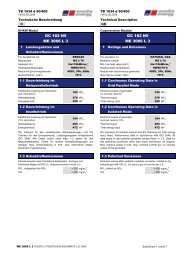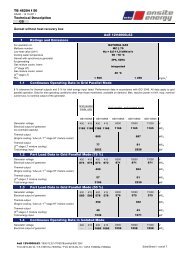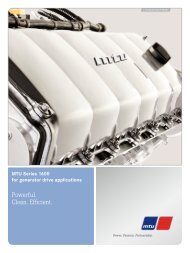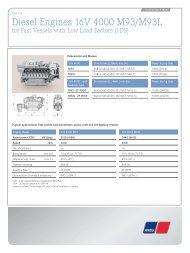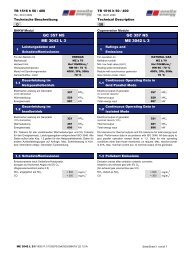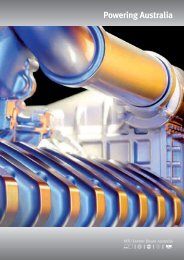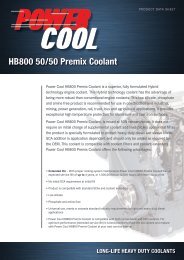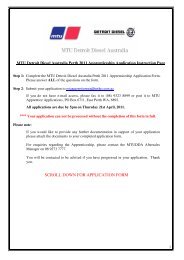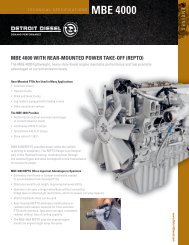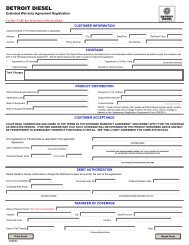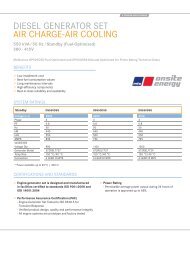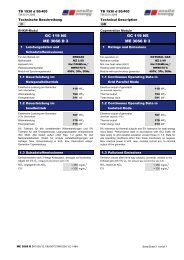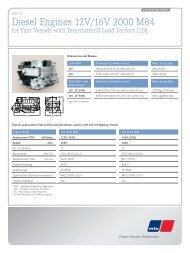DDC 2360 - MBE 900 Brochure.indd - Detroit Diesel
DDC 2360 - MBE 900 Brochure.indd - Detroit Diesel
DDC 2360 - MBE 900 Brochure.indd - Detroit Diesel
Create successful ePaper yourself
Turn your PDF publications into a flip-book with our unique Google optimized e-Paper software.
ENGINE<strong>MBE</strong> <strong>900</strong>ENGINE<strong>MBE</strong> <strong>900</strong>UNALTERED MAINTENANCE SCHEDULES.UNMATCHED SERVICE AND WARRANTY.Maintenance Intervals (Miles)Maintenance Item Severe-Duty Short-Haul Long-HaulEngine Oil and Filter Change* 6,000 15,000 20,000Fuel Filter Change 18,000 60,000 60,000Valve Lash Adjustment 24,000 75,000 80,000* Based on using <strong>Detroit</strong> <strong>Diesel</strong> approved lube oil.Severe-Duty: Less than 6,000 annual miles. Short-Haul: 6,000 to 60,000 annual miles. Long-Haul: Over 60,000 annual miles.Parts, Service and WarrantyParts and service for the <strong>MBE</strong> <strong>900</strong> engineare available at more than 800 <strong>Detroit</strong> <strong>Diesel</strong>authorized service locations throughout NorthAmerica. Factory certified technicians knowyour <strong>MBE</strong> <strong>900</strong> inside and out and are ready tohelp. For roadside assistance, technical supportor locating the nearest service center, contactthe <strong>Detroit</strong> <strong>Diesel</strong> hotline at 1-800-445-1980.Fire Truck, Bus and RV Warranty 1Application Years MilesFire Truck and EMS 5 150,000School Bus and RV* 5 Unlimited** Coverage is limited to 6,000 hours of operation.On-Highway Warranty Period for Trucks 1Warranty Limitations(Whichever Occurs First)Repair Charge to be Paid by OwnerItem Months Miles / Kilometers Parts LaborEngine 0 - 360 - 150,000 mi.0 - 240,000 kmNo ChargeNo ChargeAccessories 0 - 240 - 100,000 mi.0 - 160,000 kmNo ChargeNo Charge1Refer to the <strong>Detroit</strong> <strong>Diesel</strong> warranty parchment for full warranty details, terms and conditions.NO QUESTION ABOUT IT.The 2007 EPA diesel-emissions mandate was one of the most challenging engineering tasks <strong>Detroit</strong> <strong>Diesel</strong>has confronted, demanding more time, effort and resources than any other single program in the past severaldecades. The <strong>MBE</strong> <strong>900</strong> engine not only is far cleaner than its predecessors, it’s stronger, too.For more information, call 1-800-445-1980. www.<strong>Detroit</strong><strong>Diesel</strong>.com<strong>DDC</strong>-EMC-BRO-0015-0608. Specifications are subject to change without notice. <strong>Detroit</strong> <strong>Diesel</strong> Corporation is registered to ISO <strong>900</strong>1:2001.Copyright © <strong>Detroit</strong> <strong>Diesel</strong> Corporation. All rights reserved. <strong>Detroit</strong> <strong>Diesel</strong> Corporation is a Daimler company.
<strong>MBE</strong> <strong>900</strong>DETROIT DIESEL: DRIVING TECHNOLOGY.REFINED ENGINE COMPONENTSREFINED EXHAUST SYSTEMThe Mercedes-Benz <strong>900</strong> series engine (<strong>MBE</strong> <strong>900</strong>) has beengoing strong since we introduced it to the NAFTA medium-dutytruck market in 1998. With more than 150 years of <strong>Detroit</strong> <strong>Diesel</strong>and Mercedes-Benz collective experience designing, testingand manufacturing diesel engines behind it, it’s no wonder.Through the years, customers have turned to our engines forreliability, fuel economy, weight advantage and ease of service.That’s never changed. But, when Environmental ProtectionAgency’s ’07 requirements grew more stringent to protect theenvironment, <strong>Detroit</strong> <strong>Diesel</strong> combined our long heritage andindustry-leading innovation with the resources of our parentcompany, Daimler – the world’s largest commercial vehiclemanufacturer. Together, we did more than just meet emissionsstandards. We took our engines to the next level.With an investment of hundreds of millions of dollars and thework of the world’s top engineers, <strong>Detroit</strong> <strong>Diesel</strong> produceda new line of engines that are the most advanced andenvironmentally-friendly generation of <strong>Detroit</strong> <strong>Diesel</strong> enginesever built. We’ve lowered oil consumption. Increased responsetimes. Reduced emissions. And achieved SMART Fuel Systems.After countless laboratory tests and morethan 24 million miles in testing acrossour three enginelines, one thingisclear: <strong>Detroit</strong> <strong>Diesel</strong>isn’t justmeeting standards. ds.We’re drivingtechnology.The <strong>MBE</strong> <strong>900</strong>The <strong>MBE</strong> <strong>900</strong> has been the premium engine choice for a widerange of medium-duty and vocational vehicle buyers, poweringthe needs of food and beverage distributors, pick-up anddelivery, fire and rescue departments, school bus fleets, towtruck operators, construction companies and others. Nearly600,000 <strong>MBE</strong> <strong>900</strong> engines are in service today, more than 100,000in North America alone.With the changes required to meet the EPA’s 2007 dieselemissionsmandate, the new <strong>MBE</strong> <strong>900</strong> – now a full 7.2 liters –continues to serve its diverse customer base, offering a widerange of power ratings. With this broad spectrum of choices,buyers can spec the most economical and best matchedcomponents to fit their specific applications. Less money investedplus lower operational costs equal a better bottom line.Tightening Emissions StandardsThe EPA has been reducing diesel emissions for the past 30years. The latest regulations, which took effect in 2007, demandchanges in both fuel and engine technology. The new regulationswill dramatically reduce oxides of nitrogen (NOx) by55 percent and particulate matter (soot and ash)by90 percent. We achieved the firsttargetby optimizing the existingExhaust Gas Recirculationsystemstand the second by addingFPOan Aftertreatment System,comprised of a <strong>Diesel</strong>Oxidation Catalyst and a<strong>Diesel</strong> Particulate Filter.Exhaust Gas Recirculation (EGR)The Exhaust Gas Recirculation system has been optimized todramatically cut NOx formation by routing a measured amount ofexhaust flow to the cylinders to lower combustion temperatures.Lower temperatures result in lower NOx levels without thenegative effects of retarding engine timing. The EGR valve hasbeen moved to the top of the engine for improved serviceability.SMART Fuel SystemThe new SMART Fuel System adds to the performance andcleanliness of the <strong>MBE</strong> <strong>900</strong>. It features electronically controlledinjection nozzles capable of multiple injections per combustion cycle.<strong>Detroit</strong> <strong>Diesel</strong> Electronic Control (DDEC ® ) VI<strong>Detroit</strong> <strong>Diesel</strong> set the benchmark for diesel engine electronics.Now, we’re raising the bar with the sixth generation DDEC VIelectronic engine management system. It employs a more powerfulmicroprocessor, increased memory and enhanced diagnostics.The DDEC VI is capable of monitoring and managing all enginefunctions, including the Aftertreatment Systems required foremissions. DDEC VI is a key part of the strategy to achieve greateroperating efficiency and cleaner exhaust emissions.REFINED FUELS AND LUBRICANTSHigh Tech Grid HeaterThe <strong>MBE</strong> <strong>900</strong> is capable of starting unassisted in temperatures aslow as 10 degrees Fahrenheit. For colder temperature operation,down to –13 degrees Fahrenheit, an optional high tech grid heatercontrolled by DDEC VI is available. The high tech grid heater preheatsair in the intake system before it enters the engine duringstarting and initial warm-up. This device reduces cranking timein cold weather to increase starter life, reduces white smoke andoffers peace of mind.Maintenance-Free Electrostatic BreatherA new electrostatic breather system removes oil fromcrankcase vapor before it’s vented into the atmosphere.The system sends oil droplets back to the sump, where theycontinue to serve the engine, reducing oil consumption.And, it requires no maintenance.<strong>MBE</strong> <strong>900</strong> Engine Power RatingsStandard190 HP @ 2200 RPM 520 lb-ft @ 1200 RPM210 HP @ 2200 RPM 520 lb-ft @ 1200 RPM230 HP @ 2200 RPM 620 lb-ft @ 1200 RPM250 HP @ 2200 RPM 660 lb-ft @ 1200 RPMMulti-Functional Fuel FilterThe <strong>MBE</strong> <strong>900</strong> now features an all-new multi-functional fuel filtercontaining primary and secondary filtration, a fuel priming valveand a fuel-water separator in one compact assembly as standardequipment. The unit also may be ordered with a hand priming pump,a water-in-fuel sensor and/or a fuel heater as optional equipment.Optionalhand primerOutlet shut-off valve:return fuel to tank andair purgeReusablefilter capOutlet prefilteredfuel to pumpInlet return fuelfrom injectorsOptional integratedbracket allowsengine or frame mounting100 micron primaryprefilter/water separatorAir elimination ventStandard four micronsecondary filterIntegrated fuelpriming valve(standard)Optional 260 wattheater PTCInlet non-return valve,dirty fuel from tankLever drain withdrain hoseWater/contaminantcollection bowlWater-in-fuel sensorEngine BrakesThe <strong>MBE</strong> <strong>900</strong> engine has two engine brake options available:a compression brake and an exhaust brake. Both engine brakeoptions offer quiet operation, increased service brake life,improved driver safety and increased resale value.Exhaust Aftertreatment SystemThe biggest change to our engines is the addition of an exhaustAftertreatment System, which replaces the muffler assemblyin the exhaust system. The unit’s defining components are a<strong>Diesel</strong> Oxidation Catalyst and a <strong>Diesel</strong> Particulate Filter thatoxidize – or burn – soot. During normal highway operation,exhaust temperatures alone usually are high enough to burn offaccumulating soot, a process known as “passive regeneration.”In low ambient temperatures, however, or in some stop-and-goapplications, the system needs a little help to regenerate or cleanitself. This process is called “active regeneration.”DoserThe Aftertreatment System uses a “doser” to initiate activeregeneration. When the amount of soot inside reaches a certainlevel, the doser injects a measured amount of diesel fuel intothe exhaust flow, which reacts with the catalyst to raise thetemperature to a point that enables regeneration.There are two types of active regeneration: in-transit andstationary. In-transit regeneration occurs when the truck is inmotion. When the truck’s driving cycle is insufficient for in-transitactive regeneration, stationary active regeneration is required.This is performed when the truck is parked and monitored by thedriver or a service technician.Intake ThrottleThe intake throttle also assists in the regeneration process.When necessary, this device limits the amount of air enteringthe engine, raising the exhaust temperature and facilitatingregeneration.ULTRA LOW SULFUR DIESEL (ULSD) Fuel and CJ-4 Oil<strong>MBE</strong> <strong>900</strong> Engine Brake OptionsThe <strong>MBE</strong> <strong>900</strong> is designed to run on ULSD fuel, which can containno more than 15 PPM sulfur. Previously the sulfur content foron-highway diesel fuel was 500 PPM. ULSD fuel is necessary toavoid fouling the engine’s Aftertreatment System.CJ-4, a low ash oil formulation, is recommended in currentengines. CJ-4 oil contains less than 1.0 wt. % sulfated ash.Use of high ash engine oils reduce the cleaning interval on the<strong>Diesel</strong> Particulate Filter (DPF) system.Compression BrakeExhaust BrakeBothSingle Stage155 HP @ 2500 RPM140 HP @ 2500 RPM180 HP @ 2500 RPMwww.<strong>Detroit</strong><strong>Diesel</strong>.com



